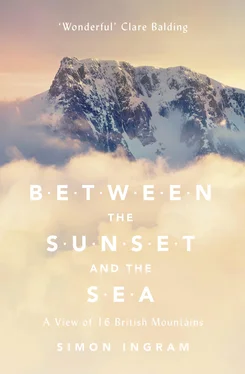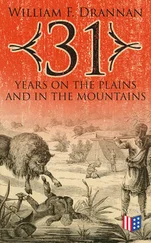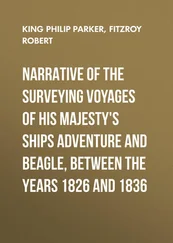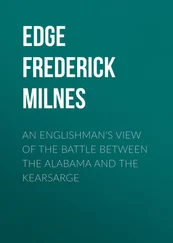The third I can remember as if it happened yesterday – and was largely the reason that I was coming back to Torridon.
It had come as Tom and I approached the top of Beinn Dearg’s pathless western flank. This was the bit I’d been worried about; the bit where the contours touched. It was indeed steep, aye; not steep enough to turn walking into climbing, but steep enough to make a slip unthinkable. As we approached the point where the flank crested and tipped into a broad summit ridge – the point at which we could put our hands in our pockets and have a bimble, apparently – the mountain began to sharpen. Suddenly the ridge wasn’t something distant and removed: we were astride it. Beinn Dearg’s grassy rump gave way to ribs of naked rock, and we began to appreciate just where we were. We were no longer climbing a hill; we were nearing the top of a mountain.
From this ridge, I looked south. Ahead, beneath the level of the high balcony on which we were standing, the edge of the mountain terminated in a vertical buttress with a void beyond. It was the same feeling of compressed perspective you might get if you looked out the window of a tall building, to its edge and beyond into the far distance, something both alarming and exhilarating; a feeling of being incongruously, deeply high – out of place, out of comfort, clinging to something that is hovering amidst nothing. You’d think that being on a mountain and feeling so delicately exposed was odd, since a mountain is by its very nature a fairly solid and sizeable thing upon which to cling. But it was less what was beyond that snared that attention; it was what was beneath.
Far below a smelt of silver was catching the afternoon sun: the river. Looking at it from this height, maybe 2,000 feet above its surface, seemed so odd, so other . This was something seen from an aeroplane, or an image pulled from Google Earth. Only it wasn’t. It was the view from my own feet. Just a couple of hours ago they had carried me across a substantial bridge on that very river and then up to a perspective from which I could view this same river not as a violent cataract of spray but as a mere vein, its motion rendered still by distance. The bridge was there, too, no longer robust and impressive but a mere staple joining the banks.
It was as if I were not looking at a living scene, but a painting in which the landscape was already interpreted by the artist. Yet here, as well, were the processes of the earth, given context and meaning by height. From this elevated perch, the way the landscape interlocked and related seemed so clear.
There was the river, the valley it cut, the sea it fed, the mountains that fed it, the sky that fed them. And the mountains, falling to earth through shades of rust-red sandstone to the grey of their quartzite flanks, to the green of the lowland scored with the deep black creases of gully and ravine.
This view changed everything for me. I’d thought I had a pretty good beat on this little country, but right then I knew that nobody had really seen Britain unless they’d seen it from a mountain. How many people missed this view? Who never got to a position where they could see this kind of sight under their own steam? What percentage of the population moved through the landscape and gazed up at the mountains, without ever realising the thrill of gazing back down upon it from them? There was, of course, the question of effort and time. Of distance and difficulty. Of danger, to a degree. But to me, at that moment, this had ceased to matter. All I felt was deep and electrifying awe.
Today I now realise that day in Torridon was an almost ridiculously fortuitous introduction to the mountains. People wait all their lives for such conditions in a place like that; I felt like I’d received a concentrated dose of beginner’s luck, like buying a toy fishing rod and landing Moby Dick on the first cast. My fascination with mountains would grow and change shape over the years for me in both a passive and fumblingly active way, but I’d never shake it. That day in 2004, a part of me woke up, and one mountain journey began.
The only other thing you need to know about me is that I’m probably just like you – that is, if you’re the sort of person who finds themselves gazing at mountains with a bit of a happily confused look on their face. Like many touched by this strange infatuation, mountains had become a big part of my life, even becoming my job in a meaningful way, as since that day in Torridon my days had been spent working for an outdoors magazine – something that put me thoroughly in touch with the physical process of climbing Britain’s mountains. I’d seen a lot, and I’d certainly learned a lot, but I’d come to realise more and more that walking to the tops of mountains was only the first step towards really getting under their skin.
And the thing is, I still wasn’t very good it. No matter how much I tried to be one of those people who could negotiate the pratfalls of equipment, navigation, physical prowess and danger with Buddha-like calm, I just wasn’t someone to whom mountain climbing came as an easy, natural fit. It took constant effort to appear even remotely competent. I forgot things. I still got lost, having a knack for losing even well-trodden paths from beneath my feet – a trait that over the years has left companions initially amused, then bewildered, then genuinely concerned there was something medical at play. And despite ten years of exposure to it, a neuro-linguistic programming course to help me overcome it, and more moments of pause than I care to recall, I was host to a concentrated – and worsening – fear of heights.
But I loved it. I absolutely loved it, in that kind of unconditional, permanent way you know you’ll be stuck with until you croak. I’d felt it slowly maturing behind the scenes over the years. It wasn’t an obsession – obsessions with mountains rarely have happy endings – and it wasn’t anything to do with ambition. I genuinely just wanted to linger in, loiter on and explore the mountains – and experience just being in these uniquely atmospheric places.
And now I was going back to where it began for me, to take the tentative first steps on another quite different mountain journey.
Over time the idea that you could gather together a small clutch of the most singularly extraordinary of the British mountains had become increasingly distracting to me. This would be a journey in search of one simple thing: what makes them extraordinary. For some of these mountains, the most amazing thing about them might be the violent voyage through time they’ve taken to get here. For others, the tales of science, endeavour and art that have played out on their slopes. The mythology they’re drenched in. The history they’ve seen. The genius they’ve inspired. The danger that draws people to them. The life that clusters around them, human or otherwise. The extreme weather they conjure. The adventure they fuel. The way that some raise the hairs on the back of your neck and trigger powerful, strange emotions. And moreover, what they’re like to be amidst, under, on – just what that indefinable quality is that the British mountains wield that takes possession of you so powerfully, and never goes away. Were you to find one mountain that best exemplifies a particular one of these conditions – a kind of natural temple to each – in a way, they would collectively comprise a kind of ultimate summit bagger’s list. Something achievable but definitive: a collective interpretation of the British mountains.
All mountains are different, of course. If you were to seek an example of every unique quality they possess the list would easily run to a thousand. But what my list would provide was a kind of experiential mountain hit list for people who don’t have the time or will to climb a thousand of them. A list that, were someone to ask you which British mountains they should climb – and you could only pick a dozen, say – would make a pretty impressive answer. This wasn’t just a ten highest, a twenty prettiest or a thirty most likely to make you shriek; it was something much more subtle and infinitely more interesting. Although I didn’t really yet know it, it would be a journey that would take over a year, and take me high into the rafters of Britain’s most forbidding, unflinching and unchanging wild places through all seasons – from the first blush of spring to the deepest, darkest bite of the mountain winter. A journey that, as it turned out, would have sixteen separate destinations. And Beinn Dearg, towards which I was driving in the slanted light of this autumnal afternoon, was the first.
Читать дальше












